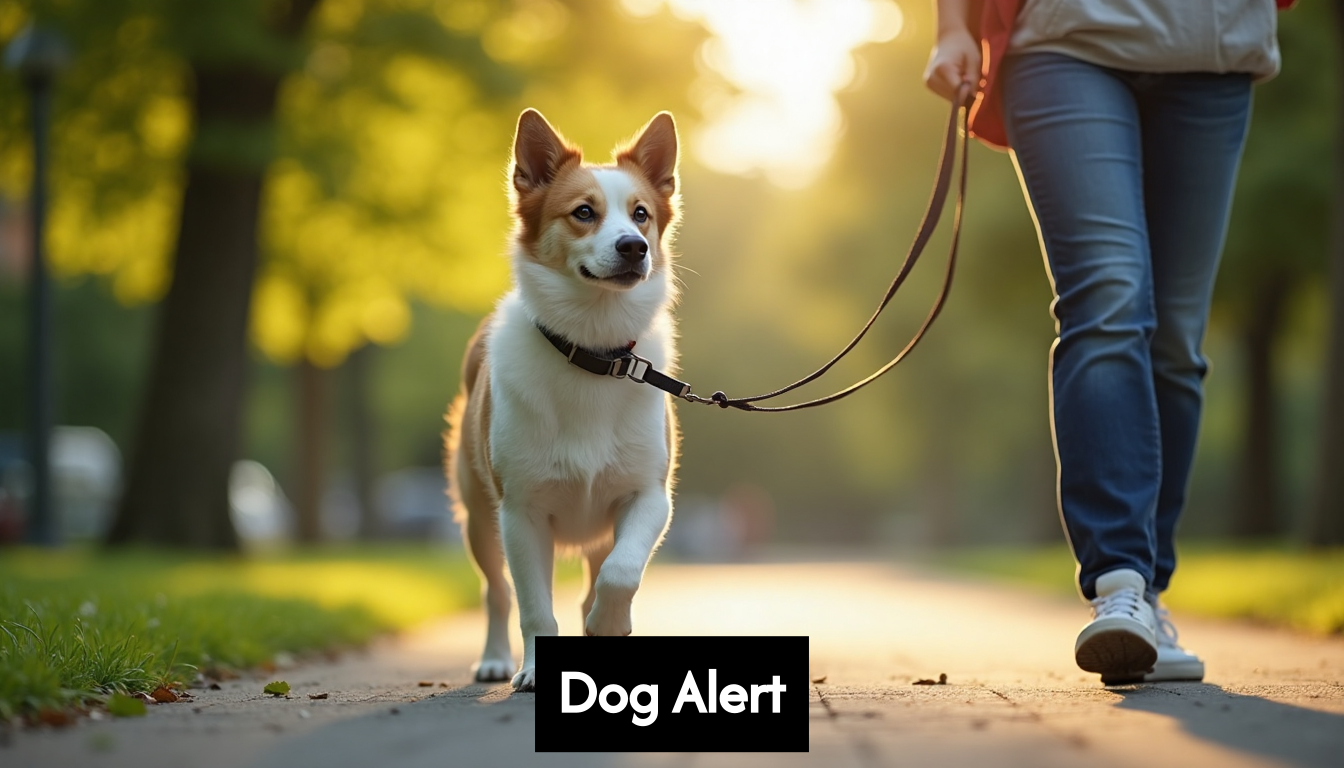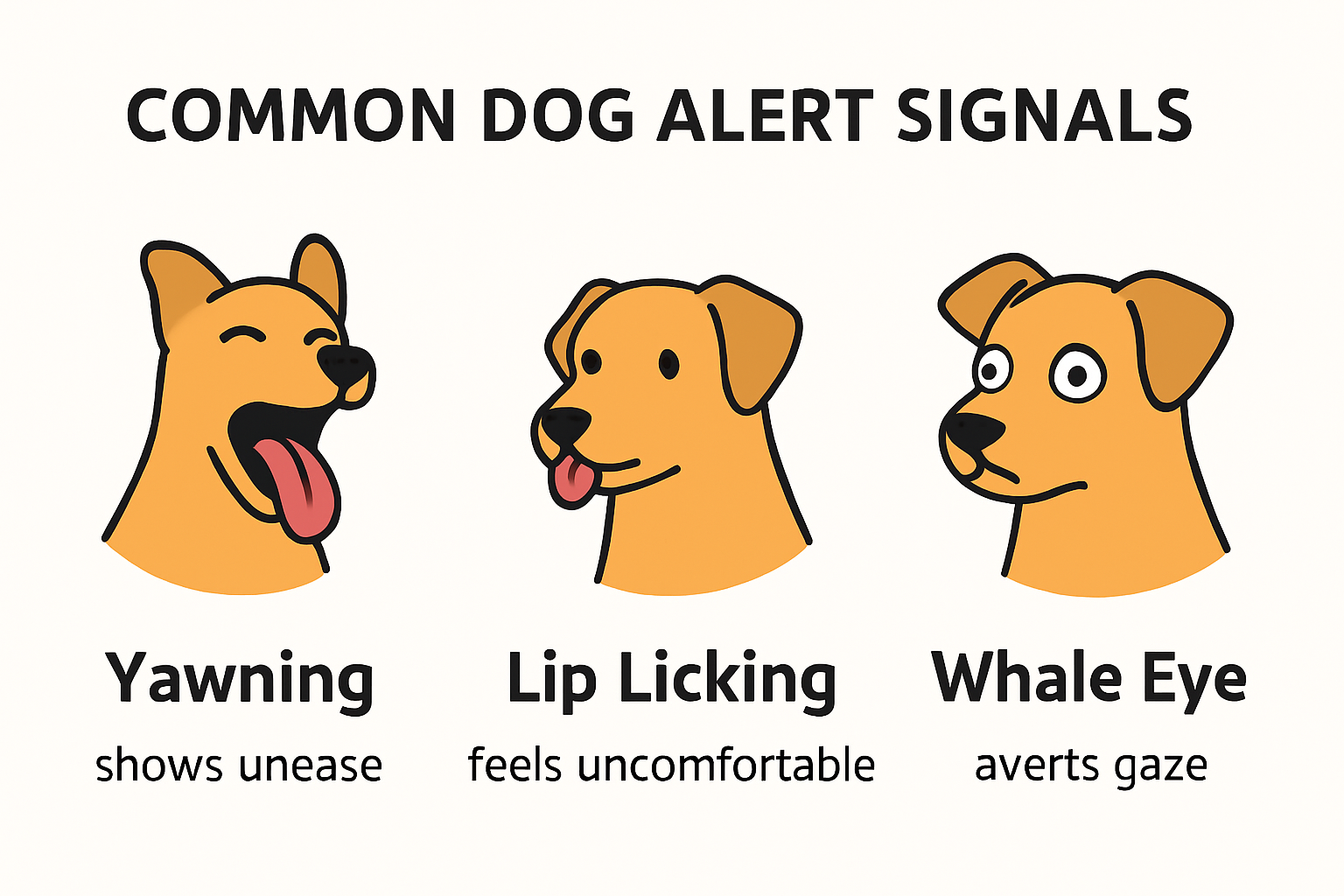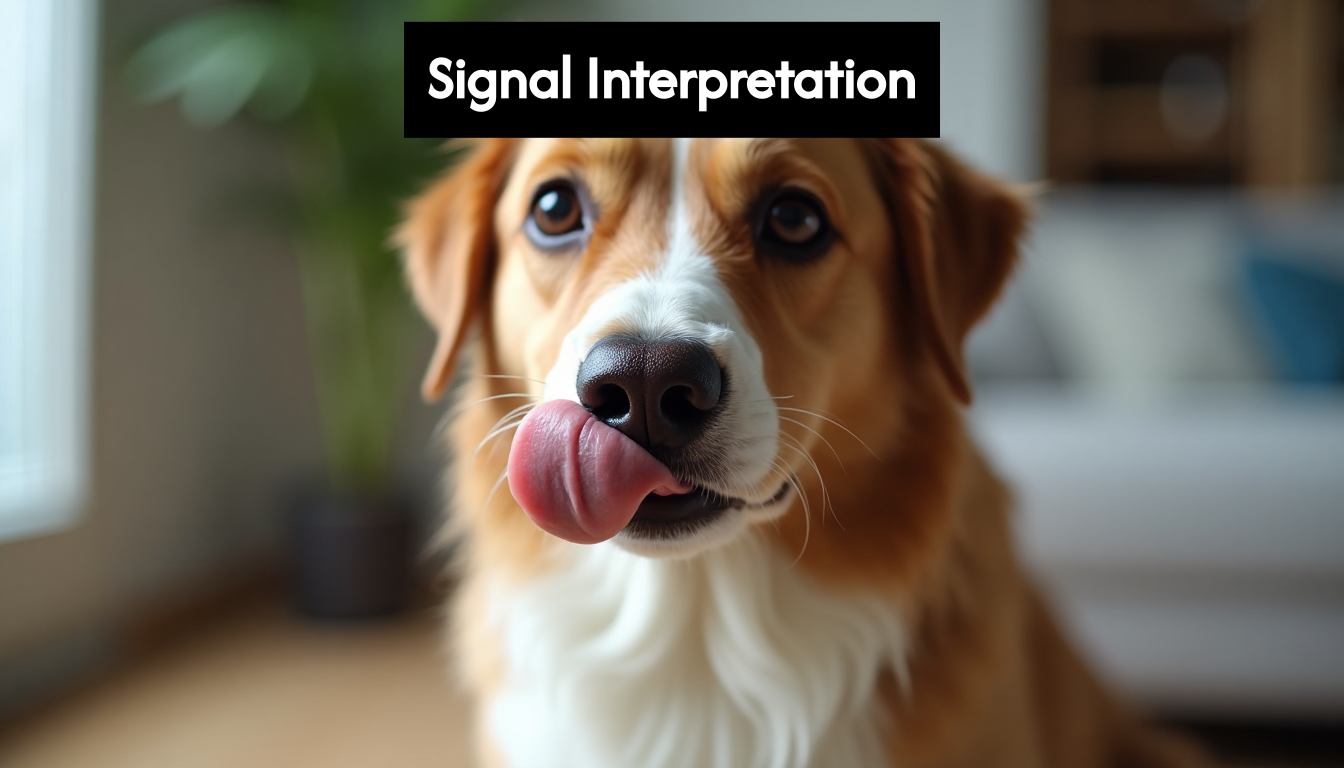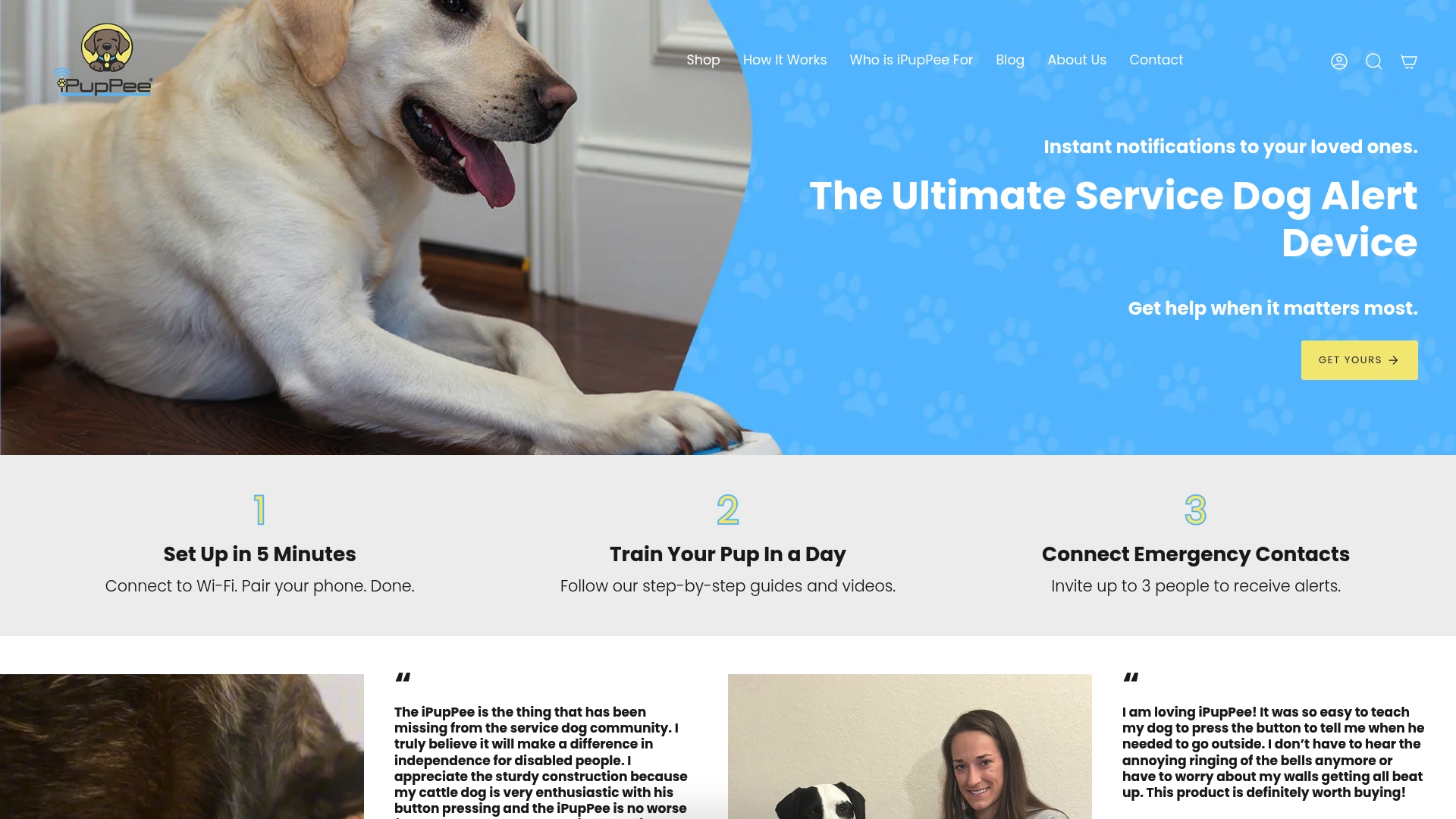
Dog alert signals can be the difference between a peaceful walk and a dangerous encounter. Surprising as it sounds, early recognition of stress signals can reduce the risk of aggressive incidents by a significant margin. Plenty of owners think a barking dog is just noisy, but the real message is hidden in subtle movements like a quick lick of the lips or the sudden flash of a whale eye. Recognizing these signals isn’t just about safety—it is the fastest way to strengthen trust and communication with your dog.
Table of Contents
- Understanding Common Dog Alert Signals
- How To Train Dogs For Effective Alerting
- Interpreting Signals In Different Situations
- Tips For Owners And Handlers To Respond Safely
Quick Summary
| Takeaway | Explanation |
|---|---|
| Recognize Dog Alert Signals | Dogs communicate through body language and behavioral signals; understanding these can prevent misunderstandings and unsafe situations. |
| Context Matters | The meaning of alert signals changes with environmental context; assess the surrounding factors before interpreting behavior. |
| Train for Effective Communication | Training should focus on developing clear alert behaviors through positive reinforcement, addressing individual dog’s learning styles. |
| Respond Calmly and Respectfully | Immediate responses should be calm and non-threatening; punishing stress signals is counterproductive and may escalate issues. |
| Utilize Technology | Emerging tools like biometric tracking and behavior analysis apps enhance understanding of dog communication and emotional states. |
Understanding Common Dog Alert Signals
Dogs communicate complex emotional states through a sophisticated system of body language and behavioral signals. Dog alert signals are critical communication tools that help owners understand their pet’s immediate needs, potential stress, or potential threats. Recognizing these signals can prevent misunderstandings and potentially dangerous situations.

Body Language as a Communication Channel
Canine communication goes far beyond barking. Dogs use intricate combinations of posture, facial expressions, and subtle movements to convey their internal state. A dog’s body becomes a nuanced language system that speaks volumes about their emotional and physical well being. For instance, subtle signals like ear positioning, tail movement, and eye contact can indicate everything from mild discomfort to serious distress.
According to research from the Canine Behavior Institute, early recognition of stress signals can significantly reduce the risk of aggressive incidents. Some key alert signals include:
- Yawning: Not always a sign of sleepiness, but often indicates stress or anxiety
- Lip Licking: A rapid tongue movement that can signal nervousness
- Whale Eye: When a dog shows the whites of their eyes, suggesting potential fear or discomfort
Contextual Understanding of Alert Signals
Understanding dog alert signals requires more than just recognizing individual gestures. Context plays a crucial role in interpreting these communication cues. A dog’s environment, previous experiences, and current physical state all contribute to the meaning behind their signals.
Our comprehensive guide on canine behavior provides deeper insights into these nuanced communication methods. Professional dog trainers emphasize that alert signals are a dog’s primary method of expressing boundaries, discomfort, or potential threats.
Specialized service dogs demonstrate an even more advanced communication system. Hearing assistance dogs, for example, are trained to provide specific alert signals to their handlers about environmental sounds or potential dangers. These dogs develop a sophisticated communication protocol that goes beyond natural canine behaviors.
Training and socialization significantly impact a dog’s ability to communicate effectively. Dogs that have been properly socialized tend to have more nuanced and clear alert signals, making it easier for humans to understand their needs and emotional states. This communication skill is particularly crucial for service dogs, who must reliably communicate critical information to their handlers.
Recognizing and responding to dog alert signals is not just about preventing negative interactions. It’s about building a deeper, more empathetic relationship with your canine companion. By paying attention to these subtle communication cues, dog owners can create a safer, more understanding environment for both themselves and their pets.
Remember, every dog is unique. While general alert signal principles apply broadly, individual dogs may have their own specific ways of communicating. Patience, observation, and a willingness to learn are key to understanding your dog’s unique communication style.
How to Train Dogs for Effective Alerting
Training dogs for effective alerting requires a strategic, patient, and scientifically informed approach. Unlike basic obedience training, alert signal training focuses on developing nuanced communication skills that enable dogs to convey critical information accurately and reliably.
Foundational Training Principles
Successful alert training begins with understanding the core principles of canine learning. Learn essential dog training techniques that create a strong communication foundation. Professional trainers emphasize positive reinforcement methods that build trust and motivation.
According to research from the Canine Behavior Institute, dogs learn most effectively through clear, consistent signals and immediate rewards. The training process involves several critical steps:
- Baseline Skill Development: Establishing fundamental obedience and attention skills
- Specific Alert Behavior Identification: Defining precise actions that constitute an alert
- Consistent Reward Mapping: Creating a clear connection between alert behavior and positive reinforcement
Advanced Alert Training Techniques
Modern alert training incorporates sophisticated techniques that go beyond traditional methods. Scientific research from the University of Lincoln reveals that intermixed training approaches can significantly enhance a dog’s ability to generalize alert behaviors across different scenarios.
Professional trainers recommend a multifaceted approach to alert training:
- Start with clear, simple alert signals
- Gradually increase complexity and environmental variability
- Use technology like smart training collars to track progress
- Implement consistent practice sessions
- Adapt training to the individual dog’s learning style
Specialized service dogs require even more advanced training protocols. Research from Medical Mutts highlights the Least Intrusive, Minimally Aversive (LIMA) principles as a gold standard in developing reliable alert behaviors.
Key considerations for effective alert training include understanding the specific needs of different dog roles. A hearing assistance dog requires different alert signals compared to an allergy detection dog. This specialization demands tailored training approaches that respect the dog’s natural communication abilities while developing precise, purposeful alert mechanisms.
Technology is transforming dog training methodologies. Emerging tools like training apps, biometric tracking, and interactive learning platforms provide unprecedented insights into canine learning processes. These innovations allow trainers to create more personalized, data-driven training experiences that optimize alert signal development.
Successful alert training is not about suppressing a dog’s natural behaviors but about channeling their innate communication skills into purposeful, reliable signals. It requires patience, consistency, and a deep understanding of canine psychology. Each dog is unique, and the most effective training programs recognize and adapt to individual learning styles and capabilities.
The ultimate goal of alert signal training extends beyond mere task completion. It’s about building a robust, trustworthy communication bridge between dogs and their handlers, enabling more meaningful and supportive interactions that enhance safety and mutual understanding.
Interpreting Signals in Different Situations
Dog alert signals are complex communication tools that change dramatically based on environmental context. Understanding these nuanced signals requires more than recognizing individual behaviors—it demands a holistic approach to interpreting canine communication across various scenarios.
Environmental Context and Signal Interpretation

Contextual interpretation is critical when decoding dog alert signals. Comprehensive safety guidelines emphasize that the same behavioral signal can mean entirely different things depending on the surrounding environment.
According to research from Dog Behavior Experts, environmental factors significantly impact how dogs communicate. A dog rolling onto its back might signal playfulness in one context but extreme stress or submission in another. Professional behaviorists recommend analyzing multiple signal clusters rather than isolated gestures.
Key environmental signal variations include:
- Home Environment: Signals related to personal space and comfort
- Public Spaces: Defensive or anxiety-driven communication
- Unfamiliar Situations: More pronounced stress indicators
Recognizing Stress and Warning Signals
Stress signals represent a dog’s primary communication mechanism for potential discomfort. Research from Canine Stress Studies reveals subtle facial expressions and body language indicators that precede more aggressive responses.
Early warning signals include:
- Excessive yawning when not tired
- Rapid lip licking
- Showing “whale eye” (whites of eyes visible)
- Tight facial muscles
- Subtle body stiffening
Professional trainers warn against punishing these communication attempts. As behavioral experts explain, suppressing warning signals can remove a dog’s critical communication method before potential confrontation, potentially increasing bite risk.
Specialized Situational Responses
Different environments demand unique alert signal interpretations. Service dogs, for instance, develop specialized communication protocols tailored to specific scenarios. A hearing assistance dog’s alert in a quiet library differs significantly from the same signal in a noisy airport.
Trainers recommend developing a comprehensive understanding of your individual dog’s communication style. Each dog develops unique signal variations based on breed, personal history, and individual personality. What constitutes a stress signal for one dog might be a normal communication method for another.
Technology is increasingly supporting signal interpretation. Advanced tracking devices and AI-powered behavior analysis tools help owners and trainers understand more nuanced communication patterns. These innovations provide unprecedented insights into canine emotional states and communication mechanisms.
Ultimately, interpreting dog alert signals requires patience, observation, and a willingness to learn your dog’s unique language. Successful communication emerges from building trust, respecting boundaries, and recognizing that each interaction is an opportunity to understand your canine companion more deeply.
Remember that no universal handbook can replace direct, compassionate observation. Your dog communicates constantly—learning to listen is the most important skill any dog owner can develop.
Tips for Owners and Handlers to Respond Safely
Responding effectively to dog alert signals requires a strategic, compassionate approach that prioritizes both human and canine safety. Dog owners and handlers must develop a nuanced understanding of communication strategies that prevent escalation and promote mutual trust.
Understanding Immediate Response Protocols
Essential dog safety guidelines emphasize the critical importance of reading and responding to your dog’s communication signals. According to Cornell Veterinary Research, immediate and calm responses can significantly reduce potential stress-related incidents.
Key immediate response principles include:
- Remain Calm: Avoid sudden movements or loud noises
- Create Space: Give the dog physical and emotional breathing room
- Avoid Direct Confrontation: Do not force interaction or make aggressive gestures
Decoding and Responding to Stress Signals
Research from Texas A&M University highlights the importance of understanding subtle stress indicators. Professional handlers recommend a systematic approach to recognizing and mitigating potential tension.
Critical response strategies for different stress signals:
- Yawning or Excessive Blinking: Reduce environmental stimulation
- Lip Licking or Nose Touching: Provide a calm, quiet retreat space
- Whale Eye or Body Stiffening: Slowly increase distance and avoid direct eye contact
Professional dog trainers emphasize that punishing warning signals is counterproductive. As experts from the California Peace Officers Standards and Training explain, growling or other warning behaviors are communication mechanisms that should be respected, not suppressed.
Advanced Communication and Safety Techniques
For service dog handlers and professional trainers, communication goes beyond basic stress management. Advanced techniques require developing a sophisticated understanding of individual dog communication patterns, environmental triggers, and personalized response protocols.
Technology is transforming how owners and handlers interact with their dogs. Emerging tools like biometric tracking devices, AI-powered behavior analysis apps, and smart training platforms provide unprecedented insights into canine emotional states. These innovations enable more precise, empathetic communication strategies.
Successful handler responses are built on three fundamental principles: observation, patience, and respect. Each interaction represents an opportunity to strengthen the human-canine bond, creating a safer, more understanding environment for both parties.
Remember that every dog is unique. While general guidelines provide a valuable framework, individual dogs develop personalized communication styles shaped by breed, training, past experiences, and individual personality. Continuous learning, open communication, and a willingness to adapt are the most important tools in any handler’s repertoire.
Ultimately, responding safely to dog alert signals is about creating a relationship of mutual trust and understanding. By approaching each interaction with empathy, knowledge, and calm consideration, owners and handlers can build stronger, more secure connections with their canine companions.
Frequently Asked Questions
What are dog alert signals?
Dog alert signals are non-verbal communication techniques used by dogs to express their emotions, needs, and potential stress. These signals include body language, facial expressions, and subtle movements, such as yawning, lip licking, and tail positioning.
How can I recognize stress signals in my dog?
Stress signals in dogs may include excessive yawning, rapid lip licking, showing the whites of their eyes (whale eye), stiff body posture, and hiding. Observing these behaviors can help you understand when your dog is feeling uncomfortable or anxious.
Why is context important when interpreting dog signals?
Context is crucial when interpreting dog signals because the same behavior can have different meanings in varying environments. For example, a dog rolling on its back might indicate playfulness in a familiar setting but may suggest submission or extreme stress in a new or threatening environment.
How can I respond safely to my dog’s alert signals?
To respond safely to your dog’s alert signals, remain calm and avoid sudden movements. Create physical space for your dog, and respect their boundaries. For specific stress signals, you should reduce environmental stimulation and offer a quiet, safe space for your dog to retreat.
Strengthen Your Dog’s Voice: Turn Alert Signals Into Real Safety
Have you ever missed a subtle dog alert signal during a walk or at home? Many pet owners worry about misreading their dog’s stress or warning signs—especially when it comes to quick yawns, lip licking, or a hidden whale eye. This article made it clear that understanding and quickly responding to these signals is not just a comfort but a crucial safety need for families, seniors, and anyone with a service dog. What if you could transform those silent cues into clear, unmistakable communication?

Let the iPupPee alert device help you break the barrier between silent signals and immediate action. With just a simple button press, your dog can notify you—making alert signals louder and safer for everyone in your home. Discover why dog owners, service dog handlers, and those who live alone trust iPupPee for peace of mind and enhanced safety. Visit ipuppee.com today to see how easy it is to improve your connection and keep your home safe. Experience clear communication and independence for you and your dog now.

